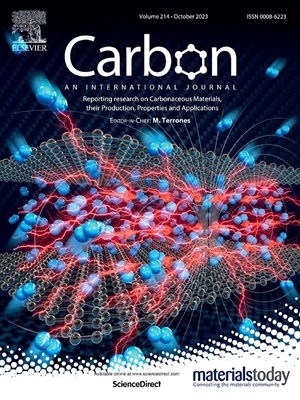Mucus-inspired hairy carbon dots for friction-dependent fluorescence in tribological interface studies
IF 10.5
2区 材料科学
Q1 CHEMISTRY, PHYSICAL
引用次数: 0
Abstract
Incorporating nano-lubricating materials as additives into liquid lubricants significantly boosts their load-bearing capabilities and friction reduction properties. In this scenario, the dispersion stability of nano-lubricating materials, influenced by multi-factor coupling such as high load, temperature variation, and shear rate, along with their interfacial transfer rate, is pivotal factors in determining the shell life and practical application of nano-lubricants. In this work, mucus-inspired hairy carbon dots nanofluids (HCG-NFs) with polyelectrolyte canopy and photoluminescent properties are presented. The as-prepared HCG-NFs has excellent dispersion stability in polyethylene glycol, and maintains stably for over six months even after being tested on a friction tester. Moreover, a unique friction-induced fluorescence attenuation effect of the nano-lubricant has been discovered, which could be leveraged to ascertain the interfacial transfer rates of carbon dots over time under conditions of friction. This work proposes a mussel-inspired biomimetic carbon dots-based mucus with excellent lubrication performance, and establishes a method for quantitatively measuring the interfacial transfer rate of carbon dots during friction process.

黏液激发的毛状碳点用于摩擦依赖荧光的摩擦界面研究
将纳米润滑材料作为添加剂加入液体润滑剂中,可显著提高液体润滑剂的承载能力和减少摩擦的性能。在这种情况下,受高载荷、温度变化、剪切速率等多因素耦合影响的纳米润滑材料的分散稳定性及其界面传递速率是决定纳米润滑材料壳体寿命和实际应用的关键因素。在这项工作中,提出了具有聚电解质冠层和光致发光特性的黏液启发毛状碳点纳米流体(HCG-NFs)。制备的HCG-NFs在聚乙二醇中具有优异的分散稳定性,即使在摩擦测试仪上进行测试,也能保持6个月以上的稳定性。此外,还发现了纳米润滑剂独特的摩擦诱导荧光衰减效应,这可以用来确定摩擦条件下碳点随时间的界面转移率。本研究提出了一种以贻贝为灵感的具有优异润滑性能的仿生碳点黏液,并建立了一种定量测量摩擦过程中碳点界面传递速率的方法。
本文章由计算机程序翻译,如有差异,请以英文原文为准。
求助全文
约1分钟内获得全文
求助全文
来源期刊

Carbon
工程技术-材料科学:综合
CiteScore
20.80
自引率
7.30%
发文量
0
审稿时长
23 days
期刊介绍:
The journal Carbon is an international multidisciplinary forum for communicating scientific advances in the field of carbon materials. It reports new findings related to the formation, structure, properties, behaviors, and technological applications of carbons. Carbons are a broad class of ordered or disordered solid phases composed primarily of elemental carbon, including but not limited to carbon black, carbon fibers and filaments, carbon nanotubes, diamond and diamond-like carbon, fullerenes, glassy carbon, graphite, graphene, graphene-oxide, porous carbons, pyrolytic carbon, and other sp2 and non-sp2 hybridized carbon systems. Carbon is the companion title to the open access journal Carbon Trends. Relevant application areas for carbon materials include biology and medicine, catalysis, electronic, optoelectronic, spintronic, high-frequency, and photonic devices, energy storage and conversion systems, environmental applications and water treatment, smart materials and systems, and structural and thermal applications.
 求助内容:
求助内容: 应助结果提醒方式:
应助结果提醒方式:


